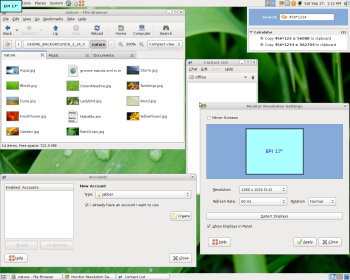Author: Jeremy LaCroix
Last week marked the release of GNOME 2.24. Those who already use GNOME will appreciate the new additions, but there’s nothing compelling enough in the new version to convince fans of other desktop environments to make a switch.
Although the upcoming releases of several Linux distributions will be including GNOME 2.24 as the default desktop, you can download and compile it yourself or by using Garnome now if you want to check it out sooner. The release notes make mention of a live CD being available, yet it’s nowhere to be found on the GNOME BitTorrent page or by Googling.
I installed a daily CD image of Ubuntu 8.10, which already includes the stable release of GNOME 2.24 by default, on my main machine, with a modest 2.6GHz AMD Athlon X2 5200+ processor, an Nvidia GeForce 8600GT video card, and 2GB of DDR2 RAM. After installing the system from the live CD, I switched the look and feel of my environment to better match how GNOME is shipped. I switched to the Clearlooks theme, and installed GNOME apps that Ubuntu doesn’t include by default, such as the Epiphany Web browser and the Empathy instant messager.
This time around, GNOME has taken an interesting step in beautifying their desktop. The project held a contest during the 2.23 development cycle in which the community was encouraged to submit custom desktop wallpaper for possible inclusion in 2.24. For some reason, Ubuntu didn’t bother to include the winning wallpapers as part of its latest CD image, but I found and downloaded them myself, and found most of them are fantastic. The art contest itself just goes to show how much better things get when you include the community in your project.
New and updated
GNOME 2.24 has no shortage of new features. One of the new additions is the Empathy instant messager client (based on the Telepathy framework), which can connect to the most common networks, such as AIM, MSN, ICQ, and others. There are great features in Empathy, such as XMPP/SIP audio and video conferencing, yet I don’t see much in it so far that makes me want to switch from Pidgin.
File browsing has also received some developer love in this update. Nautilus has gained a tabbed browsing mechanism, as well as a new “compact” view mode. You can now open a new tab by pressing Ctrl-T or by right-clicking a folder and selecting “open in new tab,” which will be familiar to anyone who uses Firefox. The compact view mode, activated by pressing Ctrl-3, shows icons with the text on the right side instead of underneath. In addition, Nautilus now detects when you are copying a file with a name that contains characters incompatible with the target file system (such as FAT), and changes the incompatible characters to an underscore automatically without you having to rename the files yourself prior to transferring.
The GNOME deskbar now includes new features such as a calculator, Google search, and Twitter plugins. To enable a plugin for the deskbar, all you have to do is right-click the deskbar icon and select Preferences to bring up a list of plugins.
Other features in GNOME 2.24 include support for the XRandR 1.2 Xorg specification (which makes it easier to add secondary monitors), sound theme support, and digital television capabilities being added to the Movie Player. For mobile users, GNOME 2.24 marks the introduciton of the GNOME mobile development platform, which provides the backbone for projects such as Ubuntu Mobile.
In addition to the features that were mentioned in the release notes, I also noticed that eject icons were added to removable media in the places list in Nautilus (though I’m not entirely certain if that is a GNOME feature or an Ubuntu tweak).
When it comes to performance, the latest GNOME release runs on par with previous versions. I didn’t notice a performance increase or decrease when compared to GNOME 2.22. Of course, some of GNOME’s performance is dependent on the theme that you use, with some engines being faster than others. Clearlooks ran the fastest on my machine.
While the community wallpapers are a great addition, the default Clearlooks theme didn’t receive much updating this time around. Fortunately, the upcoming GNOME 2.26 release is scheduled to include a new dark widget theme, which I’m looking forward to checking out.
GNOME 2.24 is a stable release; during my tests, I didn’t run into any problems. While the features in this release are good, they’re not amazing. The new features are useful and further the overall quality of the desktop, but none of them truly stands out as a game changer. Those who already use GNOME will surely enjoy all that 2.24 has to offer, but anyone who doesn’t use GNOME won’t be missing anything major.
Categories:
- Reviews
- Desktop Software



